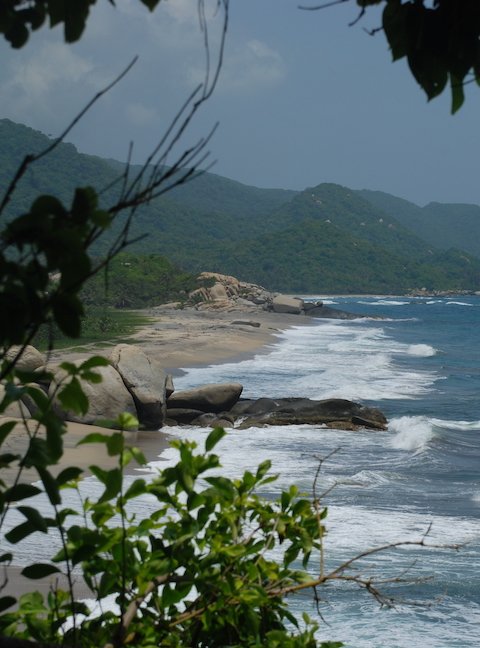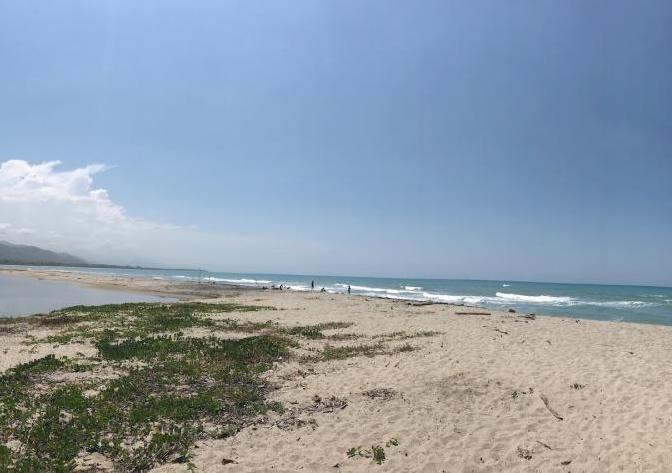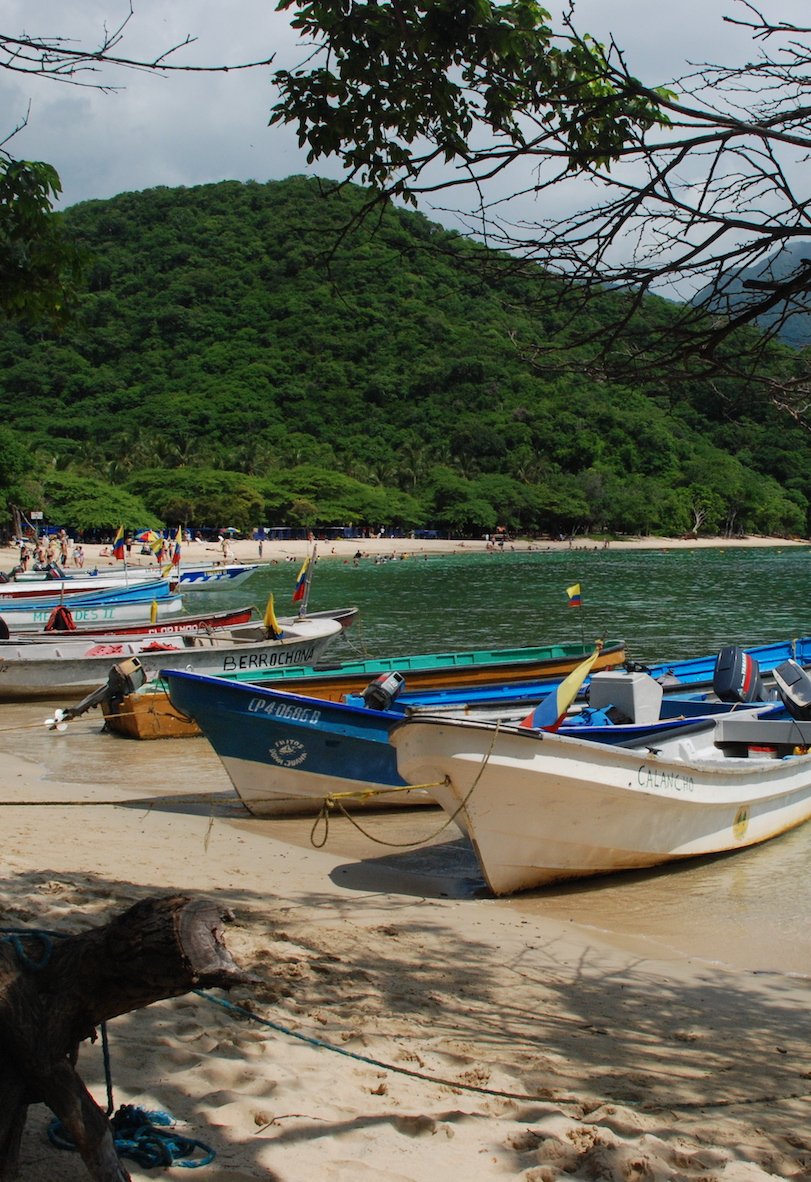Encounter Santa Marta & Tayrona
Authentic South American Experiences For Your Clients Request A Quote
Having an unrivaled architectural heritage, Santa Marta is perfect starting point to visit Tayrona National Park or visiting the “Lost City”. There is a small beach and boulevard, Santander Park and Bolivar Square are pleasant places to stroll around. Santa Marta’s climate is hot, but the sea breeze makes it pleasant to just sip from a fresh fruit juice or cocktail in one of the various open-air cafes.

GATEWAY TO A JEWEL OF COLOMBIAN NATURE

Tayrona is located on Colombia’s northern Caribbean Coast and covers 46 sq. miles (120 sq.km) on land and an additional 11.5 sq.miles (30 sq.km) underwater but much of the park still isn’t easily accessible. The National Park gets its name from the Tayrona Indians, one of South America’s greatest pre-Columbian civilizations. This area was a major trading center for the Tayrona, whose population once exceeded a million. A long string of beaches stretch for around 5 miles (8km) from the entrance of the National Park, bounded by Cañaveral to the east and ending with the famous Cabo San Juan to the west.
build your clients trip with our experts


Santa Marta & Tayrona National Park

Historical City Center
Santa Marta was the first city on Colombian territory and one of the oldest cities in the continent. The historical center is romantic, colonial and very well preserved. The Cathedral, the Santo Domingo Convent and the Tayrona Gold Museum are historical, traditional sites.

Yachting or Sailing
A great option is have lunch or dinner at Marina Santa Marta, then heading out along the coastal city and out to visit Tayrona National Park. There are a range of boating options for different traveler or group type, we recommend a handful of yachts and sailboats.

Taganga
Taganga is a small fishing village and perhaps most famous for its impressive views of the Caribbean and surrounding mountains. It’s well known for scuba diving and snorkeling. Enjoy walking the tiny town or unwind on Playa Grande, Bonito Gordo, or Bahia Cocha.

Tayrona National Park

Minca

Palomino
destination map

| Title | Address | Description |
|---|---|---|
Bogota | Bogotá, Colombia | Colombia’s capital is surrounded by cool Andean peaks and, to give you an impression of its size, it consists of approximately 1,000 neighborhoods, each adding a different angle to this lively metropolis. The city is located in the center of the country at 8,660ft (2,640m) above sea level. With people coming from all corners of the country, this capital city is as diverse as the entire country. Read more… |
Medellin | Medellín, Antioquia, Colombia | Once the home of Pablo Escobar, Medellin also known as the ‘City of Eternal Spring’ has become the Silicon Valley of South America and is a jewel in the crown of Colombia. Nowadays this thriving city is one of the safest cities in Latin America offering mountain and valley views, Medellin has a friendlier and provincial town feel to it rather than a bustling metropolis. Read more… |
Cartagena de Indias | Cartagena, Provincia de Cartagena, Bolívar, Colombia | The magic of Cartagena lies at the foundation of its fortifications, warmth of its people, wealth of its architecture and endless cultural expressions of a fierce and courageous people. Gorgeous cobblestone alleys with elegant balconies, colorful flowers, massive churches and eye-catching terraces. The city is perfect to stroll around and soak up the relaxing and sensual atmosphere. Read more… |
The Coffee Triangle | Eje Cafetero, Colombia | Exploring family-run coffee plantations, staying at gorgeous colonial-style fincas and relaxing surrounded by the region’s lush rolling hills makes Colombia’s Coffee Triangle a highlight destination in South America. The region will easily seduce you with its visually stunning and expansive views of plantations and rolling hillsides. Read more… |
Villa de Leyva | Villa de Leyva, Boyacá, Colombia | Cobblestone streets, Spanish-style villas, and small-town pace give Villa de Leyva a charming, frozen-in-time feel. Villa de Leyva and surrounding countryside are among the safest places in Colombia to wander off the beaten track to explore the multiple waterfalls, a nearby desert, adventure-sport opportunities, and even a couple of vineyards. Read more… |
Santa Marta & Tayrona | playa de Cañaveral, Santa Marta, Magdalena, Colombia | Unrivaled architectural heritage, Santa Marta is the perfect starting point to visit Tayrona National Park or visiting the “Lost City”. There is a small beach and boulevard, Santander Park and Bolivar Square are pleasant places to stroll around. Santa Marta’s climate is hot, but the sea breeze makes it pleasant to sip from a fresh fruit juice or cocktail in one of the open-air cafes. Read more… |
San Agustin & Neiva | Neiva-San Agustín, Neiva, Huila, Colombia | Neiva serves as a hub for travelers headed to San Agustin, declared a UNESCO World Heritage in 1995, San Agustín preserves the relics of a pre-Colombian culture that thrived in the area for more than 7 centuries. Visitors to the Archaeological Park can stroll back through the centuries marveling at the huge life-sized statues symbolizing fertility, maternity, and the alter ego as well as realistic and sacred animals.Read more… |
Depending on your client’s preferences, we can help you determine the best experiences tailored for your clients. From where to visit, when to go, what to do and how to get there safely, our travel experts will help you create an experience your clients will love.

Best times to
visit Santa Marta & Tayrona
In general all year round is good to visit Santa Marta and the Tayrona National Park. The days are slightly hot but the evening sea breezes and the balmy Caribbean nights will make up for it. The temperature varies between 77°F (25°C) and 86°F (30°C), depending on the location and elevation.
The summertime of June, July, August and September are the months that most people choose to visit Colombia and therefore is when Santa Marta and Tayrona are the busiest. There are two rainy seasons from May to June and from September to November, with the heaviest rainfall in the last two months of the monsoon, not usually all-day deluges but a few hours of rain everyday which make Santa Marta quite enchanting and newly washed each day.
Every year between July and August, the Sea Festival takes place in Santa Marta and is where visitors can enjoy and learn more about the Colombian Caribbean culture. There are different activities like music concerts, parades on the streets and the famous parade of boats sailing around Santa Marta bay and gastronomic festival

practical information
HOW TO GET THERE
The Simón Bolívar airport is less than 10 miles (16km) south of the Santa Marta and has non-stop flights to and from Bogota and Medellin.
Santa Marta’s bus terminal is on the southeastern outskirts of the city with several daily connections to Bogotá (18 hours), Cartagena (4 hours) and Medellin (15 hours).
To reach the Tayrona National Park you can take a bus from Santa Marta and ask the bus driver to drop you off at the National Park entrance. It is about a 1 hour journey and one that can’t be missed. You can also take the bus to the closer town of Calabozo which is another entrance to the Tayrona National Park.
GETTING AROUND
Unlike bigger cities in Colombia, taxis in Santa Marta generally do not run on a meter with payments range from a set price for a “lift” (usually a ride no more than 10 minutes) to higher prices depending on where you want to go. If you meet someone who ‘knows’ a taxi driver, this can be a good opportunity to negotiate a price to where you want to visit while staying in Santa Marta.
In the Tayrona National Park, Castilletes, the first point reached after entering from El Zaíno, offers peaceful camping with sea views. Cañaveral has some luxurious accommodation offerings and Arrecifes is mainly popular with families and those wanting to have some peace and quiet. Cabo San Juan del Guía is the most popular spot with budget travelers.
WHERE TO STAY
With Colombia’s growth in tourism, Santa Marta has experienced a real boom in accommodation offerings from comfortable B&Bs to luxurious and boutique hotels, so you’ll have plenty of choice.

more highlights of Colombia
With eight local offices in Latin America, we have the perfect base to help you build the perfect trip for your clients. Unrivaled experience with a wide selection of bed & breakfasts, small posadas, unique boutique hotels and world class luxurious lodging.
